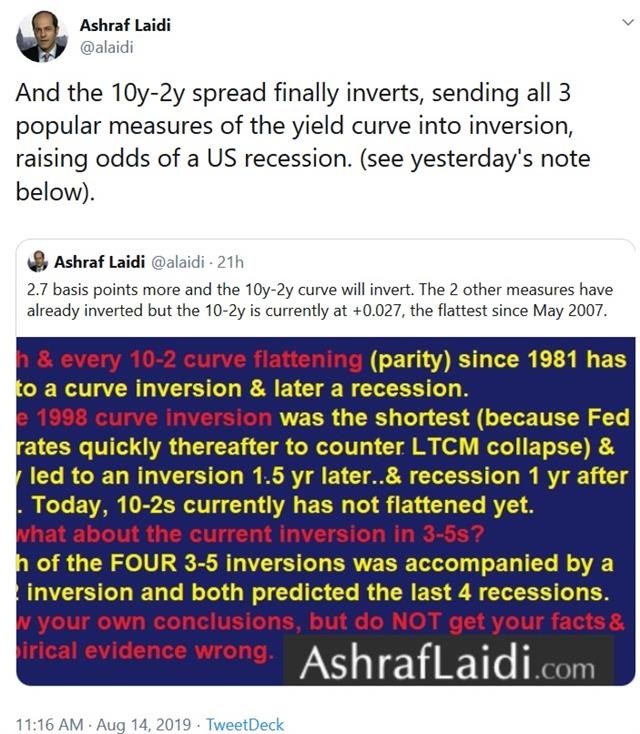President Trump gives it, market takes it away. Less than 24 hours after markets rallied 1.5% on delayed tariffs, markets tumble and yield curve inverts
President Trump gives it, market takes it away. Less than 24 hours after markets rallied 1.5% on President Trump's announcement to delay U.S. tariffs on a portion of the items due to be hit on Sept. 1, markets tumbled (624 points, -2.2% for the Dow) after the most popular measure of the U.S. yield curve (10-year Treasury notes – two-year Treasury notes) entered negative territory for the first time since May 2007. The other reason (if these matter to you) is related to China's reaction.
President Trump explained the reason to delay tariffs on many consumer products until Dec. 15 was to avoid dampening the Christmas shopping season. He also hinted that he was expecting agricultural purchases in exchange.
Chinese reports gave less on an indication of a thaw. They highlighted that it was the United States who made the call and press reports took a victory lap on the U.S. climbdown. Those aren't the actions of a country who is looking to compromise.
A Few Pointers on the Yield Curve
While a couple of measures of the yield curve inverted months ago, many analysts view the 10-year/two year spread as the true measure of the yield curve. See Ashraf Laidi’s tweet below. Bear in mind that it takes six to 12 months on average for the U.S. economy to dip into recession after the start of a yield curve inversion.

Contributing to the sell-off in indices were remarks from St Louis Fed's Bullard saying in a podcast that economic outcomes were "quite good" for the United States as far as their frameworks were concerned. And so as long as the Fed finds no reason to cut rates further and markets are distracted by daily stock market fluctuations, the macro picture will go on deteriorating (supply chains, slashed imports) until it's too late.
Adding to the angst in bonds was the July U.S. CPI report. Prices rose 1.8% year over year compared to 1.7% expected but that modest number disguises a near-term jump in core inflation. Ex food and energy, prices rose 0.3% for the month; combined with the same rise in June, that's the fastest two-month rise in the core since 2006. The flipside was the wage growth was dismal.
Adam Button is co-owner and managing director of ForexLive.com and a contributor at AshrafLaidi.com. You can see Ashraf’s daily analysis at www.AshrafLaidi.com and sign up for the Premium Insights. Ashraf's Tweet on indices here.


















